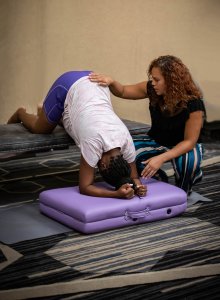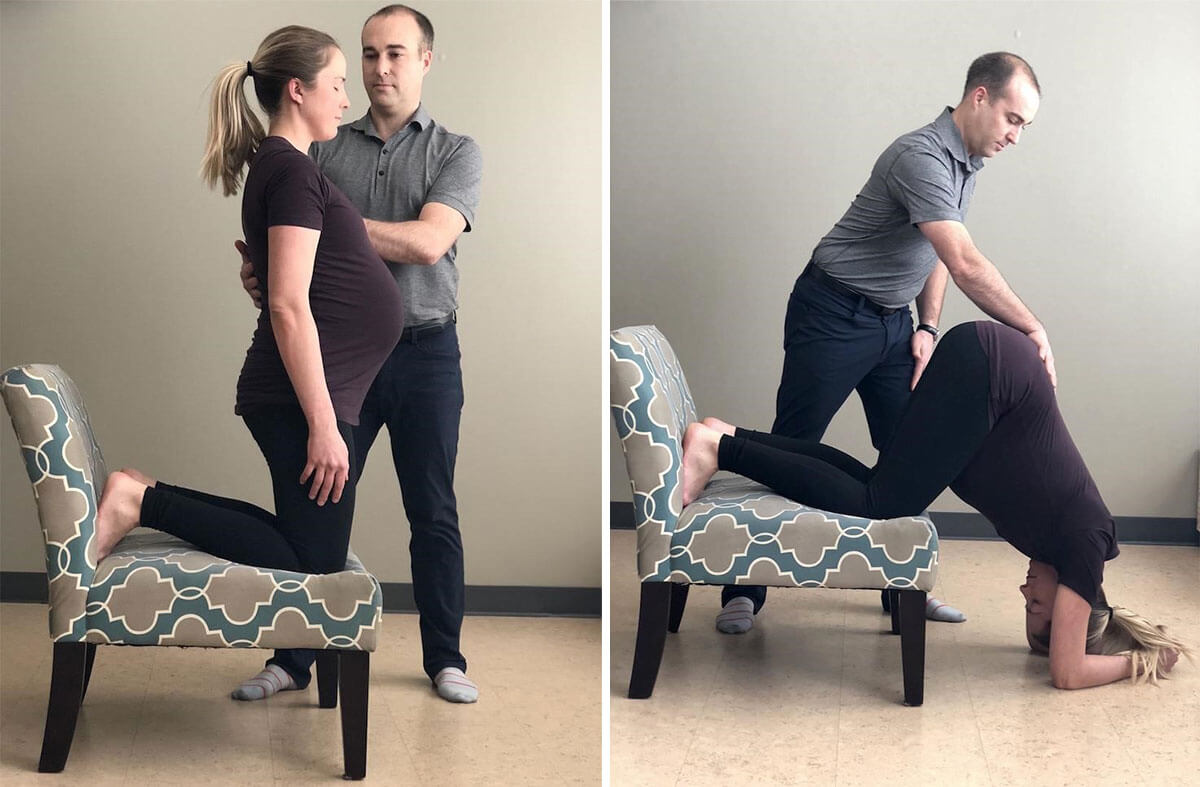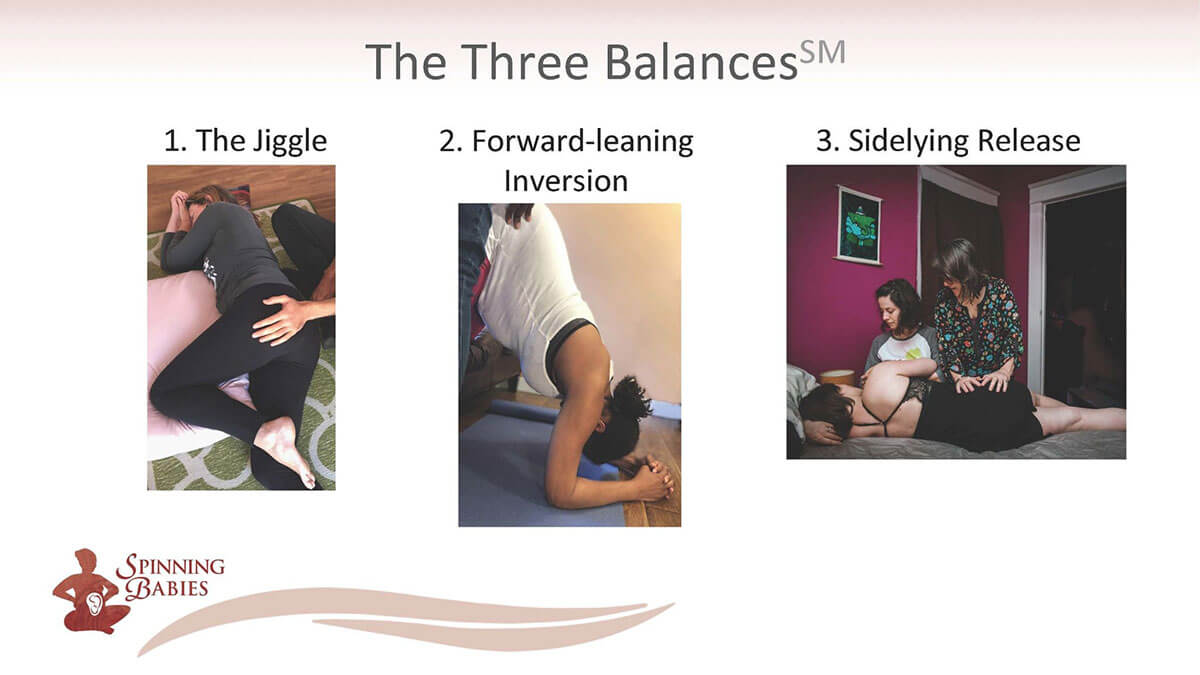
Before doing Forward-leaning Inversion (FLI), warm up your body. The risk of a fall is higher if your shoulders are stiff, or if you move too fast:

Other Things to Consider
Before beginning FLI release a recurring round ligament spasm (causing acute pain when rolling over or other shifting movements) before getting into a position like an inversion that might pull on a short and spasming round ligament. The Webster Technique of Chiropractic can release a tight round ligament.
While the FLI done regularly will strengthen the back or shoulders, some people will need to help their back become more supple and “open” their shoulders (create more range of motion by doing daily shoulder rolls) before attempting a Forward-leaning Inversion.
When one ligament isn’t the only player in an imbalance, releasing the uterosacral ligament may allow a baby to turn breech or cause some other adverse reaction. When one body part is overly tight another will be loose. We know that some people will exercise or do bodywork in one way only and not take a whole-body approach which may also cause the type of imbalance that will need more than one technique (or three!) to balance the body. Keep going and baby will return to be head down again.
Are There Any Risks?
The contribution of the FLI to improving fetal positioning, relieving lower backaches, easing dilation of the cervix, and even making room for a baby to descend in the pelvis makes it a popular technique among parents and professionals alike. But popularity doesn’t mean that there is no risk and it doesn’t mean that other techniques might be necessary to achieve ease (more comfort or labor progress).
The risk is tipping a body upside down that is ill with hypertension or vulnerable with some other risk of stroke. Weakness in the shoulders may risk a fall, so we guide parent use with safety tips on our page.
Could a baby turn breech?
It’s possible, but rare, a head down baby could turn head up after a FLI. When fluid is high and the pelvic floor is tight, doing the FLI alone in isolation may untwist one portion of the uterus but perhaps not a portion pulled by another portion of the anatomy. Theoretically, baby now has more room above but not where the head is meant to settle. Continue balancing and the baby follows the space to a head down position.
A baby can suddenly rotate and descend (or descend without rotating first). In any birth when this happens the water could break or the cord could tighten. I heard of the water breaking before labor in a person who was past their due date by a week or more. I heard of a cord tightening during the birth. Whether or not
What other activities should I be doing?
Some people need to do something more than one technique to achieve comfort or labor ease. While FLI is one of our favorite techniques, so are The Jiggle and The Side-lying Release. Psoas lengtheners, hip openers, ball squeeze, and windmills will help so many complaints of pelvic pain. Our Daily Activities page has a serious list of these pleasurable options for pregnancy.
Gain even more insights at Advanced Tips for Forward-leaning Inversion
Background
FLI comes from the creator Carol Phillips, DC, who developed this technique with her pregnancy Chiropractic and Dynamic Body Balancing genius. Dr. Carol recommends a daily inversion for the average pregnancy (no special needs to change the amount either way). Our Approved Trainers and Spinning Babies® Parent Educators teach FLI.
Since 2006, Spinning Babies® has heard excellent benefits and very few adverse reactions (like turning a head down baby breech). Anesthesiologists have agreed that a Forward-leaning Inversion, used in the way we dehttps://www.spinningbabies.com/wp-content/uploads/2019/10/sample3-1.png for labor, is acceptable during an epidural.
Midwives and Maternity Nurses trained in Spinning Babies® use FLI as a regular part of maternity care, in labor and before a manual external cephalic version to turn the breech. Spinning Babies® has received the greatest volume of feedback from the world’s use of Forward-leaning Inversion.

Make room for baby to turn with The Three Balances® at Spinning Babies®
My Baby is on my Right Side; Is the placenta location why?
“I’m 34 weeks pregnant with my first baby. My baby’s head is down and on the right side now. Our placenta is on my left side. Maybe that’s why my baby is on my right side? I am wondering how likely it would be for my baby to get on my left side if the placenta is there? Would there be enough room for the baby to move over to the left? I will be working with her by doing all of the Spinning Babies® techniques I have learned in my Parent Class with my Spinning Babies® Certified Parent Educator.” – Dawn, (edited for content)
Dear Dawn,
Welcome to Spinning Babies®! Your baby is sharing space with your placenta but also with the muscles and ligaments supporting the outside of your womb. I like to think of the placenta as a teddy bear with rhythm. Baby’s can face it or snuggle their backs up to the placenta.
The location of the placenta may be a factor in restricting rotation in a tight uterus. Fortunately, if the abdominals are not too tight and not too loose, the uterine contractions will be able to move baby past the placenta as needed, in the room you’ve made available.
More often for more people, tension on the right side of the body in the lower back, the pelvis and pelvic floor may be what holds baby to the right side. Dip the Hip and Side-lying Release are lovely to make space on the right. Add windmills (from our free Daily Activities list) and breath deeply to expand the rib cage. Belly dancing with a figure-8 move with undulating belly muscles is effective for many along with the rest of the list. A Forward-leaning Inversion may be necessary, so don’t skip that if your medical health allows your body to be upside down for a very short time.
Your baby may or may not shift over to the left in pregnancy. Being on the left is not the main point, the main point is being able to shift to the left with contractions. Shifting to the left before labor can be reassuring but isn’t the “proof” of body balance. If baby moves, wonderful. But then don’t stop with daily range of motion and body balancing activities.
Baby can move back and some do to fit the shape the uterus slips back to when body balancing doesn’t continue. Perhaps a night of restless sleep or an awkward position allows the uterus to go back to old habits, tight on the right, for instance.
Continue body balancing and protect your achievements with Rest Smart® positions so that uterine contractions during labor have an easier time to shift baby into one of the more optimal positions for baby to dip into the pelvis in early labor.
Perhaps regular body balancing will allow the contractions to move baby into the anterior position when baby engages in the pelvis. We might consider the optimal fetal positions to be

Most important that the baby’s chin is tucked when engaging and these positions are most likely to allow baby’s chin to tuck on their chest (called head flexion). Flexion allows more room to engage and to rotate in the pelvis. It’s hard for a parent to know if the chin is tucked. We add the body balancing and walking daily and if labor does do a start-and-stop, doing a series of Abdominal Lift and Tuck positions will help baby engage in the pelvis.
Which fetal position your baby picks is partly due to issues of balance but also pelvis shape. Your baby’s position may be unique to your own pelvis. A balanced pelvis allows for 1-4 good positions to help engage baby. See how labor begins for more clues to whether to add a technique or two to help baby find the room.
So, Dawn, entering the pelvis from right or left is not purely an either-or situation. It’s more likely that flexion happens on the left when people don’t add balance. But by adding balance you increase baby’s flexion even when on the right. If baby is flexed, you won’t cause too much flexion.
For now, your baby is on the right AND you can do activities so the muscles and ligaments of your body give the most room and achieve the best balance possible (Not too tight, not too loose, and not too twisty). Balancing and range of motion activities will help baby rotate towards a more anterior position, or to the left, in pregnancy or when uterine contractions make the move to engage baby into the pelvis. I hope this helps!
Find a professionals’ workshop here.